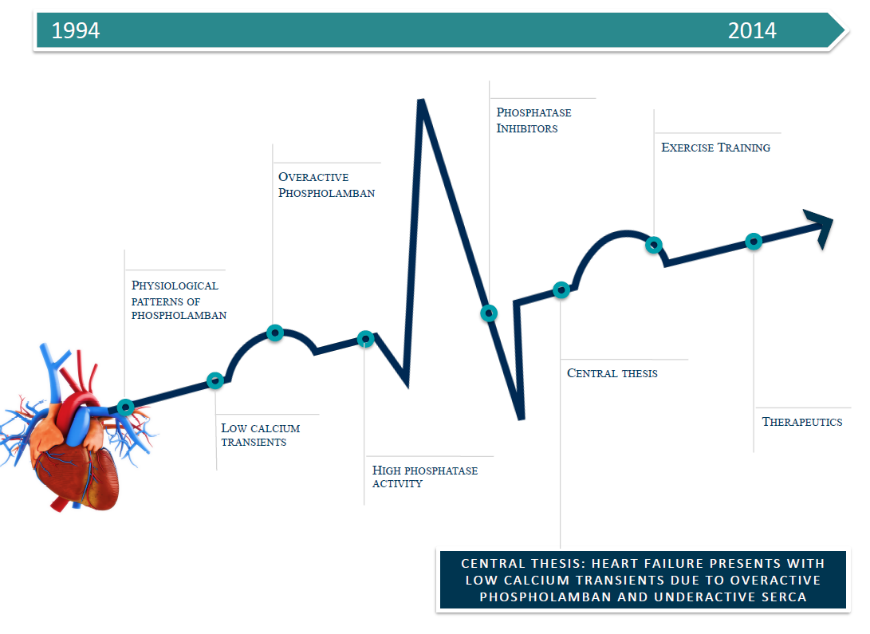Please rate these pages to support our infographic project:
Get free premium widgets for your blog and website.

A pair of phospho-specific antibodies to PLN were first described in 1994. These have been in continual use by the entire cardiac excitation-contraction coupling research community since that time, and have underpinned a series of discoveries concerning the aetiology and potential management of heart failure. In the early days, research focused on defining the normal physiological situation in the heart and the role of PLN phosphorylation in the response to stress. PLN is a small transmembrane protein expressed in the sarcoplasmic reticulum (SR) of cardiac myocytes, which interacts with the Ca2+-pump of the SR and inhibits Ca2+ transport by this pump. This inhibition is relieved upon PLN phosphorylation at Ser-16 or Thr-17 sites, Ca2+-transport into the SR is accelerated and the contraction cycle quickens and generates more force. Read full article.
- Ai, X. et al. 2005. Ca2+/calmodulin-dependent protein kinase modulates cardiac ryanodine receptor phosphorylation and sarcoplasmic reticulum Ca2+ leak in heart failure. Circulation Research. 97(12), pp.1314-1322.
- Bartholomeu, J.B. et al. 2008. Intracellular mechanisms of specific beta-adrenoceptor antagonists involved in improved cardiac function and survival in a genetic model of heart failure. Journal of Molecular and Cellular Cardiology. 45(2), pp.240-249.
- Birkeland, J.A.K. et al. 2007. Serotonin increases L-type Ca2+ current and SR Ca2+ content through 5-HT4 receptors in failing rat ventricular cardiomyocytes. American Journal of Physiology-Heart and Circulatory Physiology. 293(4), pp.H2367-H2376.
- Boknik, P. et al. 2000a. Protein phosphatase activity is increased in a rat model of long-term beta-adrenergic stimulation. Naunyn-Schmiedebergs Archives of Pharmacology. 362(3), pp.222-231.
- Briston, S.J. et al. 2011. Impaired beta-adrenergic responsiveness accentuates dysfunctional excitation-contraction coupling in an ovine model of tachypacing-induced heart failure. J Physiol. 589(Pt 6), pp.1367-82.
- Brixius, K. et al. 2003. Ser16-, but not Thr17-phosohorylation of phospholamban influences frequency-dependent force generation in human myocardium. European Heart Journal. 24, pp.16-16.
- Cheng, J. et al. 2012. CaMKII inhibition in heart failure, beneficial, harmful, or both. Am J Physiol Heart Circ Physiol. 302(7), pp.H1454-65.
- Currie, S. and Smith, G.L. 1999. Enhanced phosphorylation of phospholamban and downregulation of sarco/endoplasmic reticulum Ca2+ ATPase type 2 (SERCA 2) in cardiac sarcoplasmic reticulum from rabbits with heart failure. Cardiovascular Research. 41(1), pp.135-146.
- Denipote, F. et al. 2011. Influence of Taurine on Cardiac Remodeling Induced by Tobacco Smoke Exposure. Cellular Physiology and Biochemistry. 27(3-4), pp.291-298.
- Drago, G.A. and Colyer, J. 1994. DISCRIMINATION BETWEEN 2 SITES OF PHOSPHORYLATION ON ADJACENT AMINO-ACIDS BY PHOSPHORYLATION SITE-SPECIFIC ANTIBODIES TO PHOSPHOLAMBAN. Journal of Biological Chemistry. 269(40), pp.25073-25077.
- El-Armouche, A. et al. 2004. Ouabain treatment is associated with upregulation of phosphatase inhibitor-1 and Na+/Ca2+-exchanger and beta-adrenergic sensitization in rat hearts. Biochemical and Biophysical Research Communications. 318(1), pp.219-226.
- El-Armouche, A. et al. 2007. Decreased phosphorylation levels of cardiac myosin-binding protein-C in human and experimental heart failure. Journal of Molecular and Cellular Cardiology. 43(2), pp.223-229.
- Ferreira, J.C. et al. 2011. Angiotensin receptor blockade improves the net balance of cardiac Ca(2+) handling-related proteins in sympathetic hyperactivity-induced heart failure. Life Sci. 88(13-14), pp.578-85.
- Furieri, L.B. et al. 2011. Exposure to low mercury concentration in vivo impairs myocardial contractile function. Toxicology and Applied Pharmacology. 255(2), pp.193-199.
- Gao, M.H. et al. 2008. Adenylyl Cyclase Type VI Increases Akt Activity and Phospholamban Phosphorylation in Cardiac Myocytes. Journal of Biological Chemistry. 283(48), pp.33527-33535.
- Greenberg, B. et al. 2014. Design of a Phase 2b Trial of Intracoronary Administration of AAV1/SERCA2a in Patients With Advanced Heart FailureThe CUPID 2 Trial (Calcium Up-Regulation by Percutaneous Administration of Gene Therapy in Cardiac Disease Phase 2b). JACC: Heart Failure. 2(1), pp.84-92.
- Grote-Wessels, S. et al. 2008. Inhibition of protein phosphatase 1 by inhibitor-2 exacerbates progression of cardiac failure in a model with pressure overload. Cardiovascular Research. 79(3), pp.464-471.
- Huke, S. et al. 2011. SR-targeted CaMKII inhibition improves SR Ca2+ handling, but accelerates cardiac remodeling in mice overexpressing CaMKII delta(C). Journal of Molecular and Cellular Cardiology. 50(1), pp.230-238.
- Jiao, Q. et al. 2010. Sarcalumenin plays a critical role in age-related cardiac dysfunction due to decreases in SERCA2a expression and activity. Journal of Physiological Sciences. 60, pp.S94-S94.
- Jiao, Q.B. et al. 2012. Sarcalumenin plays a critical role in age-related cardiac dysfunction due to decreases in SERCA2a expression and activity. Cell Calcium. 51(1), pp.31-39.
- Kaumann, A. et al. 1999a. Activation of beta2-adrenergic receptors hastens relaxation and mediates phosphorylation of phospholamban, troponin I, and C-protein in ventricular myocardium from patients with terminal heart failure. Circulation. 99(1), pp.65-72.
- Kaumann, A. et al. 1999b. Activation of beta(2)-adrenergic receptors hastens relaxation and mediates phosphorylation of phospholamban, troponin I, and C-protein in ventricular myocardium from patients with terminal heart failure. Circulation. 99(1), pp.65-72.
- Kubin, A.M. et al. 2011. Role of reactive oxygen species in the regulation of cardiac contractility. Journal of Molecular and Cellular Cardiology. 50(5), pp.884-893.
- Larsen, K.O. et al. 2006. Alveolar hypoxia induces left ventricular diastolic dysfunction and reduces phosphorylation of phospholamban in mice. American Journal of Physiology-Heart and Circulatory Physiology. 291(2), pp.H507-H516.
- Ling, H.Y. et al. 2009. Requirement for Ca2+/calmodulin-dependent kinase II in the transition from pressure overload-induced cardiac hypertrophy to heart failure in mice. Journal of Clinical Investigation. 119(5), pp.1230-1240.
- Loyer, X. et al. 2008. Cardiomyocyte overexpression of neuronal nitric oxide synthase delays transition toward heart failure in response to pressure overload by preserving calcium cycling. Circulation. 117(25), pp.3187-3198.
- Maiellaro-Rafferty, K. et al. 2013. Altered regional cardiac wall mechanics are associated with differential cardiomyocyte calcium handling due to nebulette mutations in preclinical inherited dilated cardiomyopathy. Journal of Molecular and Cellular Cardiology. 60, pp.151-160.
- Medeiros, A. et al. 2008a. Exercise training delays cardiac dysfunction and prevents calcium handling abnormalities in sympathetic hyperactivity-induced heart failure mice. J Appl Physiol (1985). 104(1), pp.103-9.
- Medeiros, A. et al. 2008b. Exercise training delays cardiac dysfunction and prevents calcium handling abnormalities in sympathetic hyperactivity-induced heart failure mice. Journal of Applied Physiology. 104(1), pp.103-109.
- Michael, A. et al. 2004a. Glycogen synthase kinase-3beta regulates growth, calcium homeostasis, and diastolic function in the heart. J Biol Chem. 279(20), pp.21383-93.
- Michael, A. et al. 2004b. Glycogen synthase kinase-3 beta regulates growth, calcium homeostasis, and diastolic function in the heart. Journal of Biological Chemistry. 279(20), pp.21383-21393.
- Mishra, S. et al. 2005. Reduced sarcoplasmic reticulum Ca2+ uptake and increased Na+-Ca2+ exchanger expression in left ventricle myocardium of dogs with progression of heart failure. Heart Vessels. 20(1), pp.23-32.
- Moilanen, A.M. and yliopisto, O. 2012. Identification of Noval Drug Targets for the Treatment of Heart Failure. University of Oulu.
- Molenaar, P. et al. 2007. (-)-Adrenaline elicits positive inotropic, lusitropic, and biochemical effects through beta2 -adrenoceptors in human atrial myocardium from nonfailing and failing hearts, consistent with Gs coupling but not with Gi coupling. Naunyn Schmiedebergs Arch Pharmacol. 375(1), pp.11-28.
- Mork, H.K. et al. 2009. Slowing of cardiomyocyte Ca2+ release and contraction during heart failure progression in postinfarction mice. American Journal of Physiology-Heart and Circulatory Physiology. 296(4), pp.H1069-H1079.
- Mork, H.K. et al. 2007. Increased cardiomyocyte function and Ca2+ transients in mice during early congestive heart failure. Journal of Molecular and Cellular Cardiology. 43(2), pp.177-186.
- Mostarda, C. et al. 2011. Baroreflex Sensitivity Impairment Is Associated With Cardiac Diastolic Dysfunction in Rats. Journal of Cardiac Failure. 17(6), pp.519-525.
- Munch, G. et al. 2000. SERCA2a activity correlates with the force-frequency relationship in human myocardium. Am J Physiol Heart Circ Physiol. 278(6), pp.H1924-32.
- Munch, G. et al. 2002. Evidence for calcineurin-mediated regulation of SERCA 2a activity in human myocardium. J Mol Cell Cardiol. 34(3), pp.321-34.
- Quaile, M.P. et al. 2009. Direct Inotropic Effects of Exogenous and Endogenous Urotensin-II Divergent Actions in Failing and Nonfailing Human Myocardium. Circulation-Heart Failure. 2(1), pp.39-46.
- Quaile, M.P. et al. 2007. Reduced sarcoplasmic reticulum Ca2+ load mediates impaired contractile reserve in right ventricular pressure overload. Journal of Molecular and Cellular Cardiology. 43(5), pp.552-563.
- Rastogi, S. et al. 2011. Myocardial transfection with naked DNA plasmid encoding hepatocyte growth factor prevents the progression of heart failure in dogs. American Journal of Physiology-Heart and Circulatory Physiology. 300(4), pp.H1501-H1509.
- Rodrigues, B. et al. 2011. Hyperglycemia can delay left ventricular dysfunction but not autonomic damage after myocardial infarction in rodents. Cardiovasc Diabetol. 10, p26.
- Rolim, N.P. et al. 2007. Exercise training improves the net balance of cardiac Ca2+ handling protein expression in heart failure. Physiol Genomics. 29(3), pp.246-52.
- Sande, J.B. et al. 2002. Reduced level of serine(16) phosphorylated phospholamban in the failing rat myocardium: a major contributor to reduced SERCA2 activity. Cardiovascular Research. 53(2),
- Simmerman, H.K. and Jones, L.R. 1998a. Phospholamban: protein structure, mechanism of action, and role in cardiac function. Physiol Rev. 78(4), pp.921-47.
- Simmerman, H.K.B. and Jones, L.R. 1998b. Phospholamban: Protein structure, mechanism of action, and role in cardiac function. Physiological Reviews. 78(4), pp.921-947.
- Thireau, J. et al. 2012. Functional evidence for an active role of B-type natriuretic peptide in cardiac remodelling and pro-arrhythmogenicity. Cardiovascular Research. 95(1), pp.59-68.
- Thireau, J. et al. 2014. Beta-adrenergic blockade combined with subcutaneous B-type natriuretic peptide: a promising approach to reduce ventricular arrhythmia in heart failure? Heart. 100(11), pp.833-41.
- Vanzelli, A.S. et al. 2013. Integrative Effect of Carvedilol and Aerobic Exercise Training Therapies on Improving Cardiac Contractility and Remodeling in Heart Failure Mice. Plos One. 8(5).
- Wehrens, X.H.T. et al. 2006. Ryanodine receptor/calcium release channel PKA phosphorylation: A critical mediator of heart failure progression. Proceedings of the National Academy of Sciences of the United States of America. 103(3), pp.511-518.
- Williams, I.A. and Allen, D.G. 2007. Intracellular calcium handling in ventricular myocytes from mdx mice. American Journal of Physiology-Heart and Circulatory Physiology. 292(2), pp.H846-H855.
- Woldbaek, P.R. et al. 2005. Daily administration of interleukin-18 causes myocardial dysfunction in healthy mice. American Journal of Physiology-Heart and Circulatory Physiology. 289(2), pp.H708-H714.
- Yatani, A. et al. 2006. Down regulation of the L-type Ca2+ channel, GRK2, and phosphorylated phospholamban: protective mechanisms for the denervated failing heart. Journal of Molecular and Cellular Cardiology. 40(5), pp.619-628.
- Zhao, X.Y. et al. 2008. rAAV-asPLB transfer attenuates abnormal sarcoplasmic reticulum Ca2+-ATPase activity and cardiac dysfunction in rats with myocardial infarction. European Journal of Heart Failure. 10(1), pp.47-54.
- Zhu, W.-Z. et al. 2003. Linkage of β(1)-adrenergic stimulation to apoptotic heart cell death through protein kinase A–independent activation of Ca(2+)/calmodulin kinase II. Journal of Clinical Investigation. 111(5), pp.617-625.
Back to main infographic.
About us

